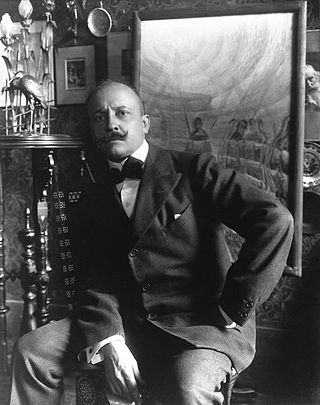
Filippo Tommaso Emilio Marinetti was an Italian poet, editor, art theorist, and founder of the Futurist movement. He was associated with the utopian and Symbolist artistic and literary community Abbaye de Créteil between 1907 and 1908. Marinetti is best known as the author of the Manifesto of Futurism, which was written and published in 1909, and as a co-author of the Fascist Manifesto, in 1919.

Futurism was an artistic and social movement that originated in Italy, and to a lesser extent in other countries, in the early 20th century. It emphasized dynamism, speed, technology, youth, violence, and objects such as the car, the airplane, and the industrial city. Its key figures included Italian artists Filippo Tommaso Marinetti, Umberto Boccioni, Carlo Carrà, Fortunato Depero, Gino Severini, Giacomo Balla, and Luigi Russolo. Italian Futurism glorified modernity and, according to its doctrine, "aimed to liberate Italy from the weight of its past." Important Futurist works included Marinetti's 1909 Manifesto of Futurism, Boccioni's 1913 sculpture Unique Forms of Continuity in Space, Balla's 1913–1914 painting Abstract Speed + Sound, and Russolo's The Art of Noises (1913).
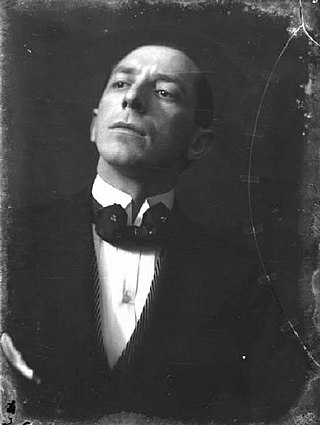
Umberto Boccioni was an influential Italian painter and sculptor. He helped shape the revolutionary aesthetic of the Futurism movement as one of its principal figures. Despite his short life, his approach to the dynamism of form and the deconstruction of solid mass guided artists long after his death. His works are held by many public art museums, and in 1988 the Metropolitan Museum of Art in New York City organized a major retrospective of 100 pieces.

Giacomo Balla was an Italian painter, art teacher and poet best known as a key proponent of Futurism. In his paintings, he depicted light, movement and speed. He was concerned with expressing movement in his works, but unlike other leading futurists he was not interested in machines or violence with his works tending towards the witty and whimsical.

Gino Severini was an Italian painter and a leading member of the Futurist movement. For much of his life he divided his time between Paris and Rome. He was associated with neo-classicism and the "return to order" in the decade after the First World War. During his career he worked in a variety of media, including mosaic and fresco. He showed his work at major exhibitions, including the Rome Quadrennial, and won art prizes from major institutions.

Cubo-Futurism or Kubo-Futurizm was an art movement, developed within Russian Futurism, that arose in early 20th century Russian Empire, defined by its amalgamation of the artistic elements found in Italian Futurism and French Analytical Cubism. Cubo-Futurism was the main school of painting and sculpture practiced by the Russian Futurists. In 1913, the term "Cubo-Futurism" first came to describe works from members of the poetry group "Hylaeans", as they moved away from poetic Symbolism towards Futurism and zaum, the experimental "visual and sound poetry of Kruchenykh and Khlebninkov". Later in the same year the concept and style of "Cubo-Futurism" became synonymous with the works of artists within Ukrainian and Russian post-revolutionary avant-garde circles as they interrogated non-representational art through the fragmentation and displacement of traditional forms, lines, viewpoints, colours, and textures within their pieces. The impact of Cubo-Futurism was then felt within performance art societies, with Cubo-Futurist painters and poets collaborating on theatre, cinema, and ballet pieces that aimed to break theatre conventions through the use of nonsensical zaum poetry, emphasis on improvisation, and the encouragement of audience participation.

Futurist architecture is an early-20th century form of architecture born in Italy, characterized by long dynamic lines, suggesting speed, motion, urgency and lyricism: it was a part of Futurism, an artistic movement founded by the poet Filippo Tommaso Marinetti, who produced its first manifesto, the Manifesto of Futurism, in 1909. The movement attracted not only poets, musicians, and artists but also a number of architects. A cult of the Machine Age and even a glorification of war and violence were among the themes of the Futurists - several prominent futurists were killed after volunteering to fight in World War I. The latter group included the architect Antonio Sant'Elia, who, though building little, translated the futurist vision into an urban form.
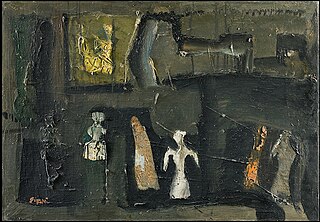
Mario Sironi was an Italian Modernist artist who was active as a painter, sculptor, illustrator, and designer. His typically somber paintings are characterized by massive, immobile forms.

The City Rises (1910) is an oil painting by the Italian painter Umberto Boccioni. It was his first major Futurist work.

Fillìa was the name adopted by Luigi Colombo, an Italian artist associated with the second generation of Futurism. Aside from painting, his works included interior design, architecture, furniture and decorative objects.
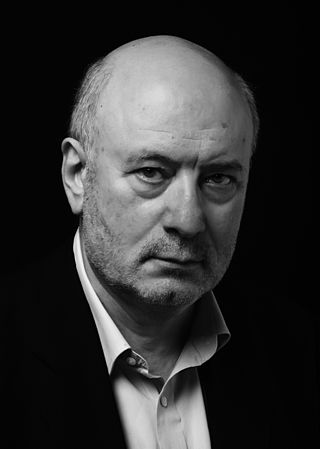
Giovanni Lista is an Italian art historian and art critic, resides in Paris. He is a specialist in the artistic cultural scene of the 1920s, particularly in Futurism.
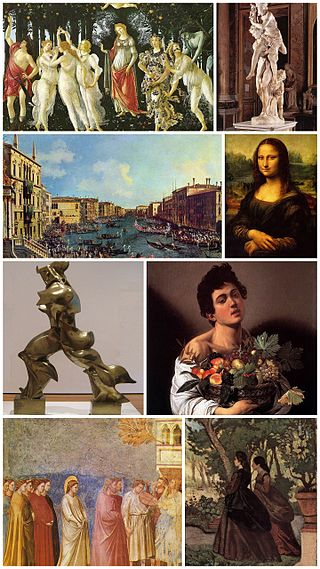
Italian Contemporary art refers to painting and sculpture in Italy from the early 20th century onwards.

The Street Enters the House is a 1912 oil-on-canvas painting by Italian artist Umberto Boccioni. Painted in the Futurist style, the work centres on a woman on a balcony in front of a busy street, with the sounds of the activity below portrayed as a riot of shapes and colours.
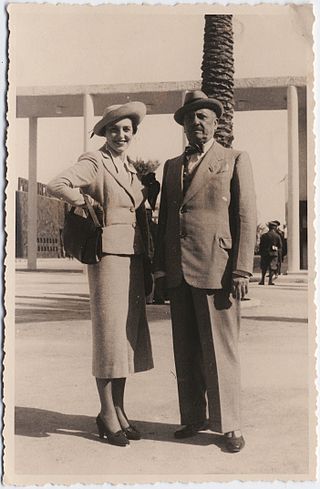
Benedetta Cappa was an Italian futurist artist who has had retrospectives at the Walker Art Center and the Solomon R. Guggenheim Museum. Her work fits within the second phase of Italian Futurism.

Girl Running on a Balcony is a 1912 painting by Giacomo Balla, one of the forerunners of the Italian movement called Futurism. The piece indicates the artist's growing interests in creative nuances which would later formally be realized as part of the Futurist movement. The artist was heavily influenced by northern Italians' use of Divisionism and the French's better-known pointillism. Created with oil on canvas just on the brink of World War I, the Futurist movement is embodied by a dark optimism for a future of speed, turbulence, chaos, and new beginnings. Most of Giacaomo Balla's pieces allude to the wonder of dynamic movement, and this painting is no exception. The oil painting is now in the Museo del Novecento, in Milan.

Dynamism of a Cyclist is a 1913 oil painting by Italian Futurist artist Umberto Boccioni (1882–1916) that demonstrates the Futurist fascination with speed, modern methods of transport, and the depiction of the dynamic sensation of movement.
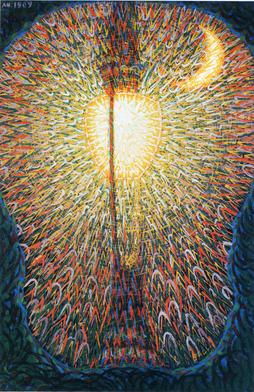
Street Light (also known as The Street Light: Study of Light and Street Lamp (Suffering of a Street Lamp)) (Italian: Lampada ad arco) is a painting by Italian Futurist painter Giacomo Balla, dated 1909, depicting an electric street lamp casting a glow that outshines the crescent moon. The painting was inspired by streetlights at the Piazza Termini in Rome.

Růžena Zátková, also called Rougina Zatkova, was a painter and sculptor who has been regarded as the "only authentic Czech futurist." As a result of her Bohemian heritage and her decade-long residency in Rome, Růžena Zátková became an important artistic link between Russian and Italian Futurism. Zátková is considered one of the pioneers of kinetic art.

Dynamism of a Human Body: Boxer is a 1913 dynamism drawing created by the futurist Italian artist Umberto Boccioni. The work was intended to show a subject in between a state of motion and stillness.
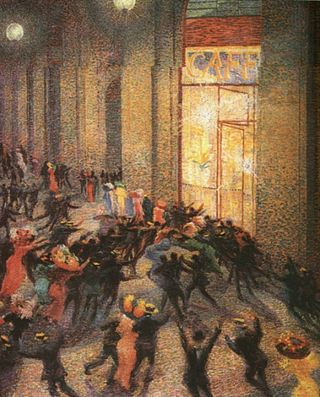
Riot in the Gallery is an oil-on-canvas painting by the Italian painter Umberto Boccioni, one of the main figures of the futurist movement. This painting was created in 1910 and it was first called A Brawl. Its dimensions are 74 × 64 cm and it is now in the Pinacoteca di Brera in Milan.




















